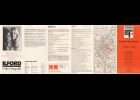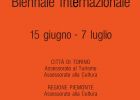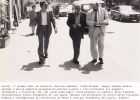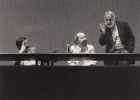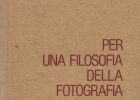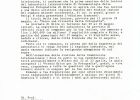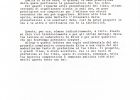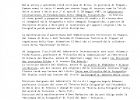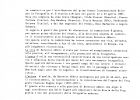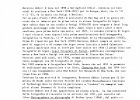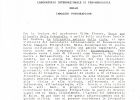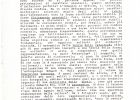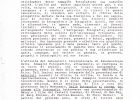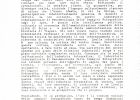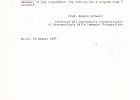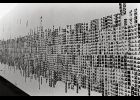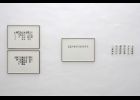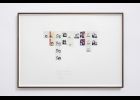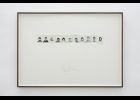Flusser Studies 19 - May 2015 / Special Italian Issue
Da soggetti a progetti. L'abbandono dell'Humanismus in Vilém Flusser
By focusing on two of Flusser’s last writings, this essay tries to address the question of the relationship between Flusserian thought and the tradition of humanism. Moving towards a form of intersubjectivity based on dialogue and mutual responsibility, Flusser succeeded in breaking the bonds that bind the contemporary subject to modernity’s unbearable burden. He described the meaning of a contemporary becoming human in a very distinctive way. Indeed, the trajectory drawn by Flusser is not entirely superimposable on the actual vernacular of post-humanism and I believe that its deepening could open us up to more responsible ways to deal with technological development and “post-humanist technologies”.
Naturalmente artificiale. Natura e cultura a volo d’uccello
What can still be defined as ‘authentic’ in our world today? Is it true that we are interested only in the ‘authentic’ nature (or what we think it is)? What does ‘authentic’ mean in relation to nature? In the essays of Vogelflüge, published for the first time in São Paulo in 1979 under the title Natural: mente, Vilém Flusser investigates the paradoxical connection between the concepts of authenticity and artificiality, proposing the cultural form of nature as a model of the natural form of culture. As occasional philosophy from a bird’s-eye perspective, the volume is the expression of an experimental method of thought and writing, which corresponds to the essentially utopian nature of the human being. The full postmodern consciousness of the difference between the need for authenticity and the impossibility of satisfying it, explains Flusser’s phenomenologically distanced, yet poetic approach to the natural simulacra of his own culture.
Ménage à trois: Riflessioni sulle nozioni di diafanità e trasparenza nell’opera di Mira Schendel, Jean Gebser e Vilém Flusser
This paper deals with the difficult friendship between Mira Schendel and Vilém Flusser, as well as the role, which the life and work of the German philosopher, writer, and translator Jean Gebser (1905-1973) played in their dialogue. In the late 1960s, Schendel and Flusser studied and discussed Gebser’s Ursprung und Gegenwart. Schendel, who visited Gebser in Switzerland in 1968, was profoundly influenced by his spiritual view of reality and used his notion of Diaphanität (transparency) to interpret her own early work. In a few essays and in the Bodenlos’ chapter dedicated to Schendel, Flusser reinterpreted the work of the Brazilian artist in terms of his own philosophy, transforming the religious notion of Diaphanität into the sole ability to see beyond the surface of things. This, however, is only one aspect of the complex relationship between the three thinkers. The paper also deals with the impact the text in Bodenlos had on the Flusser-Schendel relationship and with the pervasive influence of Gebser’s work upon Flusser’s thought between the 1950s and the 1980s. Gebser’s model of the four different and succeeding Bewußtseinsmutationen, mutations of conscience, proposes five different dimensions (Bewußtseinsstrukturen), which move from zero to the fourth dimension. This notion can also be found in Flusser’s model of code evolution, which he developed in Into the Universe of Technical Images. Flusser proposed five stages, which move, however, in reverse, from four to zero dimensionality.
Il flusso di Flusser: una prospettiva ubiqua oltre il contemporaneo
Vilém Flusser introduces a Kulturrevolution produced by computers and by the universe of technical images, leading to a re-conceptualization of society and identity, thus producing a complex theory of the media. According to Flusser, communication always depends on the media and upon each medium’s own logic and ways of transmitting information. By changing the structure of the media, information also changes, and at the same time, the reality we experience. Flusser describes this communicational revolution starting from the proliferation of images into multi-visual information. The collapse of texts and the hegemony of images, according to Flusser, led to a revolution of technical images, which no longer refer to an existing world, but to the concepts that we make. Technical images are born to rebuild guidance and a re-conquest of sense perception. The screen becomes the place, the skin in which the philosophy of feeling is currently developing. Through this new mirror-device (the screen), we have an aesthetic touch-screen that redefines our gestures. While McLuhan communicates, Flusser “envisions,” and Roy Ascott produces visions. Technologies and miniaturization invade the body inside and outside, thus bringing the digital world into the physical one, within and around us: ubiquitously. The new situation, beyond contemporary communication, is producing a new type of media: moist media. This advancing, post-digital mutations, imply a variable reality while our space-time dimension becomes an exciting constellation of Flusser's flows and movements.
Dancing Data. Come riportare lo spazio e il tempo nell'universo digitale
Flusser's philosophy of photography foresees how the introduction of digital apparatuses in all fields of human life will lead towards complete automation, and the programs running this technology will be progressively integrated within a large meta-program, a “super-black-box,” working independently from human intention. This analysis echoes Evgeny Morozov’s (2013) writings against the idolization of “The Internet,” the magic machine that is believed to offer a solution for every human problem. As Flusser predicted, and Morozov showed with contemporary examples of digital mediation, this super-black-box works in fact only towards the implementation of its own mechanisms of control. Flusser’s apocalyptic prediction, however, is counterbalanced by the idea that forms of “play against the apparatus” will offer mankind the means to regain freedom of action. This paper looks at forms of control and emancipation in the relations between club culture members and digital media. Social media changed the way clubbers share and represent their experiences, undermining presence in a culture that was traditionally based on intense bodily experiences. Therefore, new forms of playful interaction, such as forms of dance or fights between clubbers and the digital apparatus might emerge; new forms of DJ-ing that might lead towards a new understanding of presence and participation.
Vampyroteuthis Infernalis: l’alterità capovolta
The Vampyroteuthis Infernalis is a text that defies labels by layering scientific, philosophical, and anthropological perspectives. We should read it “lengthwise” in order to share the vision of this brilliant metaphorical story and post-human fairy tale. Flusser eradicates points of view that are rusty, ancient and anthropocentric. In this, he sheds a beam of light not only on the ideas but also on the method, and the point of view. Throughout the book, the literary device turns out to be a kind of powerful “antivirus” against the rhetoric and the morals of our “a priori”. The Vampyroteuthis emerges where we dive: it is the dark side, the sleep of reason and the monster of dreams; it is the common unconscious, the fear of the unknown, the repression of drives; it is what is submerged by science and religion; it is the black, the different, the other; it is what we would like to suppress in ourselves, but actually, if this emergence is slow and conscious, the subsequent integration will be healthy and productive. It will be the utopia of new humans who look out and see themselves.
Vilém Flusser in Italia una testimonianza di Angelo Schwarz sollecitata da Valentina Bonizzi
Angelo Schwarz and Valentina Bonizzi, Vilém Flusser in Italy
Angelo Schwarz re-traces the context in which Flusser operated in Italy with a detailed historical perspective, which he weaves together with the memory of his personal relationship with Flusser. In this text Schwarz is asked to answer a question that he first posed in 1985 at the workshop Torino Fotografia 85, “What legitimates photography?” With the methodology of the historian, he re formulates the question in “what is photography,” and with careful attention to details, people, and dates, he goes back to the pre origins of photography, bringing the reader to the very act and materiality of the process. Whereas Flusser does not speak of concrete images in his writing, Schwarz insists in finding the answer to his question in the ontology of the photographic image in the “truth” of the technical process.
Che cosa legittima la fotografia? La produzione di un incontro tra Flusser e Vaccari
This paper describes the meeting between Flusser and the Italian artist and theorist Franco Vaccari in 1985 and 1987, and focuses on the philosophical, epistemological, and ethical basis of photography. The text is linked to the interview with Angelo Schwarz and the pictures at the end of this issue (Flusser in Italy). “What legitimates photography?” was a question proposed in the context of the symposium Torino Fotografia 1985. Today, the question is asked to address the “encounter” between Vilém Flusser and the artist Franco Vaccari. The latter is followed by a magnifying lens looking at the documentation of the real meeting between the two in 1985, but without the intention of finding the “proof.” While for Flusser, the invention of photography points to the beginning of a Post-Historical era in which he examines concepts of freedom and responsibility by combining the notion of the apparatus with the experience of exile, Vaccari activates the apparatus, and at the same time, lets his work be activated by it. In this way, the responsibility belongs to the apparatus itself, and the concept of freedom becomes a modus vivendi in which the photographer uses the apparatus to create meanings and “has a chance to discover what he didn’t know.” This process is weaved in the essay with interventions by Roberta Valtorta, who offers a socio-political overview of the photography context in Italy, and Franco Vaccari, who carefully thinks about an open answer for what can legitimize photography, as well as a related essay by Angelo Schwarz, the original author of the question which gives the title to this essay. The question of the legitimization of photography unravels through a methodology that explores what photography “becomes” by calling attention to the “subjects” of photography—or, as Ariella Azoulay defined, “the citizens of photography.”
Documenti peripatetici:Vilém Flusser, Angelo Schwarz, Franco Vaccari
The following images have ben curated by Valentina Bonizzi in the context of the two papers Vilém Flusser in Italia una testimonianza di Angelo Schwarz sollecitata da Valentina Bonizzi and Che cosa legittimizza la fotografia? La produzione di un incontro tra Flusser e Vaccari. The images and the documents have been donated by the Archivio Istituto di Scienze delle Immagini e della Comunicazione.
Torino 1985
Torino Fotografia ’85: Both Vilém Flusser and Franco Vaccari participated in the event, which was curated by Angelo Schwarz.
Flusser’s first Italian publication: Per una filosofia della Fotografia, 1987, Agorà Editore, Torino
Erice 1987
Verso una teoria dei gesti
In his work “Gesten. Versuch einer Phänomenologie,” Flusser investigates the concept of gestures. Starting from a first definition of gestures, which explores the “causality” of movements, Flusser then discusses the meaning of the concept “gesture” in the broader context of culture as a symbolic expression. In this essay, we discuss Flusser’s view on gestures by studying them with respect to their function and meaning in communicative processes, both obvious and hidden. From a semiotic point of view, we analyse Flusser’s thoughts on the function and the properties of gestures and provide a definition of “gesture”, which reflects its cultural, symbolic, and significant aspects. Particular emphasis is given to the role of gestures in communicative processes and their imbedding in the cultural environment.
Tutta un’altra Storia? Social network, narrazioni e identità digitali
The identity of individuals in a community, and in a “distributed” form of community, such as the social network, is formed/informed by relationships. The growing availability of information about these connections allows the quantification of social behaviors. Digital identities can be analyzed to identify – and spread – models, that is, generalizations created from the statistics of occurrences and patterns of words and colors, not just interpretations. The digital man is a “deluge of forms” more than a “material man” and the social networks design aims to in-form in order to control the actual and possible forms of a human being. Digital identities have been a proscenium of freedom and alternatives, but are now turning into stories written by the design of social networks and by the political and economic interests that drive such designs. This paper presents a reflection on these actualities, through an ideal conversation between Vilém Flusser and a few contemporary artists, sociologist, and philosophers.
Della banalità del male (traduzione di Francesco Emilio Restuccia)
In this article, published in 1969, Flusser rethinks the concept of the banality of evil, which Hannah Arendt developed in her book Eichman in Jerusalem, in the chapter “A Report on the Banality of Evil” (1963). Unlike Arendt, Flusser is more interested in the trivial evil: the one produced by those who need to live with an apparatus (e.g. a factory or a school), even if they are responsible and well-educated. And given that nowadays, we increasingly cannot live without the apparatus, we should rather try to understand how we can be free with them.
